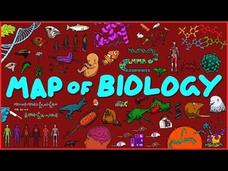Curated OER
How Do You Simplify a Mixed Expression Over a Mixed Expression?
You will need to pay close attention while watching this video. There are many steps and many operations to do to simplify this algebraic fraction. If it seems hard the first time you watch it and you miss something, then watch it again....
Educator.com
Areas Between Curves
There are times that it is necessary to add areas to find the area between the curves. The video for AP Calculus presents how to find the area between curves by subtracting the area under the lower curve from the area under the upper...
Math Antics
Dividing Fractions
Division of fractions is more than keep, change, flip. A video explains the reason to use the reciprocal when dividing fractions. Using the interpretation of fractions as division problems, the video explains the relationship of dividing...
Krista King Math
Rationalize an Imaginary Denominator with Conjugate Method
Explore a procedure for rationalizing a denominator that includes imaginary terms with a video that shows how to use a conjugate when working with fractions. The narrator explains the process from start to finish with each step shown in...
Curated OER
Level 1 Exponents
Both positive and negative numbers play a part in this video. Here, Sal explains the definition and function of exponents. Especially helpful for those with the tendency to multiply an integer by its exponent, this video offers several...
Curated OER
Level 1 Exponents
Both positive and negative numbers play a part in this video. Here, Sal explains the definition and function of exponents. Especially helpful for those with the tendency to multiply an integer by its exponent, this video offers several...
Crash Course
Simple Animals: Sponges, Jellies, and Octopuses
A video focusing on the evolutionary history of simple animals reveals some amazing facts. Did you know that some deep-water sponges can live to be more than 200 years old? The narrator of the film explains what simple animals means,...
Khan Academy
Logical Operators
As the author in this video states, "life is complex", and to handle this complexity, programming languages use something called Boolean operators. This video shows how to setup a conditional statement that relies on both of two things...
Domain of Science
The Map of Biology
Many define biology as the study of life but can't agree on a definition of life. Trying to explain all of the domains and subdomains of biology seems a bit easier than defining life. See a full map of the topics covered by the general...
Khan Academy
Government's Financial Condition
What goes into accounting the United States budget deficits and its net operating costs? How do shifts in the economy affect government spending? How is increasing interest projected to affect our federal debt in the future? This video...
Crash Course
Age of Jackson
Review the depth and complexity of Andrew Jackson's presidency and the beginnings of modern American politics with this engaging video. Topics covered include: the second bank of the United States, the Missouri Compromise, the rise of...
Crash Course
Reconstruction and 1876
How did the United States face the problem of needing to integrate a formerly slave and rebellious population back into the country? Your young historians will learn about the complex system of reconstruction that existed in post-Civil...
Be Smart
The Science of Snowflakes
We are all the same, yet we are all different—just like snowflakes. Learners explore the science behind snowflakes and their uniqueness as they view the video segment on snow. They conclude with a discussion about physical and chemical...
SciShow
Strong Interaction: The Four Fundamental Forces of Physics #1a
The strong force holds quarks together to form hadron particles, which include baryons and mesons. Common baryons, such as protons and neutrons, are the focus of a video that shows how they use the strong force. Then it explains the...
Code.org
How Computers Work: Binary and Data
There are two types of people in the world: those who understand binary and those who do not. Pupils watch a video that describes how computers store information using binary code. They learn how programmers can encode text, images, and...
PBS
The Ghostly Origins of the Big Cats
A lack of fossil records forces scientists to piece together the evolution of the big cats. The PBS Eons video lesson describes the processes scientists use to infer evolutionary details and predict possible species. Scholars get an...
Curated OER
How Do You Convert a Mixed Expression To a Rational Expression?
Given a monomial and a polynomial, rewrite the expression as a rational number. This is not as confusing as you might think. First is to make the monomial a rational number by giving it a denominator. Once that is done, numbers can be...
Curated OER
How Do You Simplify a Mixed Expression Over a Mixed Expression?
You will need to pay close attention while watching this video. There are many steps and many operations to do to simplify this algebraic fraction. And if it seems hard the first time you watch it and you miss something, then watch it...
Krista King Math
Divisibility
Examine the processes for determining the divisibility of a number. Some divisibility rules are simple, such as divisible by two or five, while others are more complex. The video explains the divisibility rules for numbers from two...
PBS
Annelid Animation: Body Plan
Annelids evolved with powerful muscles to dig deep into the ground. Scholars observe the body segments, muscle pattern, unique gut, and the whole body circulatory and nervous systems. Highly detailed animation provides a view of the...
Math Antics
Comparing Fractions
Comparing fractions, it is just not the same as comparing whole numbers. The video starts with fractions with common denominators and moves on to comparing fractions that are not as obvious. Scholars learn two techniques, cross...
Brightstorm
Introduction to Polar Coordinates - Concept
Learning polar coordinates does not require visiting the North Pole, though explaining igloos is much easier using polar coordinates. The lesson begins with a video explaining how to find coordinates on a spherical plane and how to...
Educreations
The pH Scale
The pH scale is actually based on logarithms rather than just simple numbers. The fact-filled video begins with an explanation of the auto-ionization of water. Then it describes the relationship between H+ and OH- in every solution. It...
Educreations
The pH Scale
The pH scale is actually based on logarithms rather than just simple numbers. The fact-filled video begins with an explanation of the auto-ionization of water. Then it describes the relationship between H+ and OH- in every solution. It...
Other popular searches
- Imaginary Complex Numbers
- Algebra Complex Numbers
- Algebra 2 Complex Numbers
- Classifying Complex Numbers
- Complex Numbers Table
- Trigonometry Complex Numbers
- Equations Complex Numbers
- Converting Complex Numbers
- Sum of Complex Numbers
- What Are Complex Numbers
- Roots of Complex Numbers
- Precalculus Complex Numbers

























